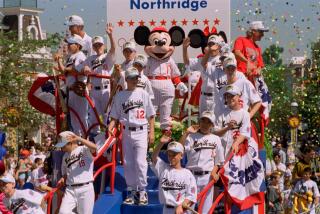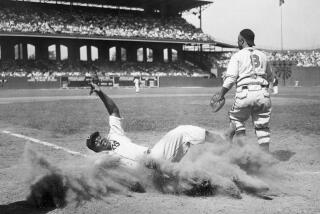Baseball’s not quite cricket in South Africa
Reporting from Johannesburg, South Africa — The first thing you notice about the baseball field at Weltevreden Park Primary School is that there is no pitcher’s mound. There’s no infield either. No backstop. No dugouts.
When one team arrives early for its scheduled Sunday morning game, the players have to borrow a baseball from two kids playing nearby just to warm up.
“Welcome to Fenway Park,” Ashley Petersen says with a shrug and a smile.
Petersen, a youth baseball coach, might be the most avid Boston Red Sox fan in South Africa. He is also among his country’s most energetic advocates for a sport battling long odds to flourish in a landscape crowded by rugby, cricket, soccer, and track and field.
“The minute you say, ‘Hey baseball,’ they say, ‘But there’s no baseball being played here in South Africa,’” says Petersen, a stout, tireless man. “It’s very difficult.”
It’s getting better though. A decade ago, nearly 100 amateur clubs with about 30,000 players were active, says Edwin Bennett, executive director of South African Baseball, which oversees the sport in this country. Now, participation in adult and youth leagues is estimated at more than 250,000 players.
That’s about a third of what rugby claims. But it’s a start.
“It’s a process,” Bennett says. “It has to be a process because there’s no quick change.”
That much was obvious on a recent chilly morning at Weltevreden Park when the Welties Bombers and the Cobras, ranging in age from 14 to 42 and wearing mismatched uniforms, met in a Major B league game, the second-highest level of play in South Africa.
The field was just that — a field, with no pitcher’s mound, no dirt infield and no backstop to intercept the wild pitches that constantly eluded both teams’ catchers. A rugby goalpost towered above the half-dozen plastic lawn chairs that made up the third base dugout. Another goalpost loomed as an obstacle in deep right-center field. There was no seating for the two dozen or so spectators, some of whom brought their own chairs.
Because the bases were not tethered to the ground, they shot into the outfield every time a runner slid into one. And the Bombers’ middle infielders — a left-handed second baseman with no cap and a stocky shortstop — looked more like a tag-team wrestling duo than one of the lithe, agile, double-play combinations familiar to American baseball fans.
Even the incessant dugout chatter was decidedly South African in its gentility.
“That was a nice point of contact, eh?” a coach shouted, more as a question than a statement, after a Bombers batter surprised everyone by hitting a line drive.
When a runner strayed too far from the base, a coach cautioned him to be wary of a pickoff attempt by the hard-throwing — relatively speaking — pitcher.
“That boy can whip the ball in there quite rapidly,” she said.
Not surprisingly, the game turned sloppy. The teams combined for 11 errors, seven walks, six wild pitches and eight stolen bases. Afterward, Bombers third baseman Imraan Jacobs shook his head in disappointment.
“When I was a teenager, baseball was actually quite high, the level of baseball,” he said. “It’s gone down. But it’s picking up again. We’ll have to wait and see from here.”
Like most South African baseball players, Jacobs came to the sport from cricket, which he found too slow and lacking the strategic dimension of baseball with its hit-and-run plays, sacrifice bunts and pinch-hitters.
“I thought at the time that cricket was kind of boring,” says Jacobs, who began playing baseball in primary school. “My sister played softball, so that’s where I acquired the taste for it. From the moment I picked the ball up, I knew then I had to play.”
Keenan Petersen, the Bombers’ 15-year-old catcher and Ashley Petersen’s son, says his love of baseball isn’t something he brags about to friends.
“They say, ‘Baseball in South Africa?’ and they laugh,” Petersen says. “And I say, ‘Come down on a Sunday and see.’”
Few have taken him up on the offer, although Petersen has been scouted by the Pittsburgh Pirates, who discovered Gift Ngoepe in a neighboring park league two years ago. Ngoepe, now an infielder for the Pirates’ affiliate in the Florida State League, is one of a record six South Africans in the U.S. minor leagues and perhaps the best player in his country’s history.
Still, Kansas City Royals scout Mike Randall, one of two full-time professional scouts working South Africa, says the country is “a long, long way” from producing a major league player.
“It’s going to take a while,” says Randall, whose most recent find, pitcher Dylan Kevin Lindsay, has a 1-0 won-lost record and an impressive 1.42 earned-run average in his first eight games in the rookie-level Arizona Summer League. “But we’ve got good athletes. In cricket and rugby, South Africa is among the top teams in the world. With baseball being a smaller sport in my country, it hasn’t gotten the focus and attention that the others have. But it’s growing.”
Randall lives in Cape Town, which, along with the Indian Ocean port of Durban, formed the country’s baseball hotbed before the sport began spreading in Johannesburg. In recent years, the game has moved into the countryside and the black townships.
Like everything in South Africa, baseball was once segregated. Many in the sport’s current leadership, including Bennett and Petersen, were part of the anti-apartheid movement and saw baseball as an extension of that struggle.
“I fought on the baseball fields. We never threw bombs. We never shot at anybody,” says Bennett, 63, a mixed-race South African. “We used just our voices and our presence. And we made changes in our country. We have paid our dues.”
As recently as 2000, South Africa’s national team was all white. Today, more than 80% of the participants in youth leagues are black or colored, a recent study found. As a result, the country’s national baseball team is now among the most diverse of any in South Africa.
But to draw South Africa’s best athletes — black or white — away from cricket, rugby and soccer, which all have thriving professional leagues, baseball will have to offer similar opportunity for fame and fortune, Bennett says. That’s why he’s trying to put together a professional league similar to the fledgling baseball circuits in Australia and China.
“Hopefully, we’ll get the good athletes attracted to baseball,” Bennett says. “The reason why they have gone to cricket is because there was no professional baseball for them. You have to give them a lure.”
Major League Baseball is also helping the sport grow. Weekly ESPN games are shown here via satellite TV. MLB’s Pitch, Hit and Run program has provided equipment and instruction to grade-school children in places where the cash-strapped South African Baseball federation couldn’t afford to. MLB also invited South Africa to participate in the first two World Baseball Classics, helping to raise the profile of the sport here. (The South African national team has yet to win a game in the tournament.)
Paul Archey, MLB’s senior vice president for international business operations, says the recent development of South Africa’s elite program, which recruits and trains the country’s best players, compares favorably with that of Australia. That country, which had only three players in the U.S. minor leagues in the early ‘90s, now has nearly 100 playing professionally in the U.S. and Canada. Twenty-three Australians have reached the major leagues in the last two decades.
South Africa, with more than twice as many people as Australia, thinks it can do better.
“We’ve just seen a massive growth in the youth divisions. And that takes a while to come to the top,” Bennett says.
Back on the mound at Weltevreden Park, Tim Wesley, a skinny right-hander who pitches with his shirt untucked and who, for no apparent reason, wears a batting glove on one hand and sweat bands on both elbows, is putting the finishing touches on a complete-game, two-hit victory.
His second pitch of the morning shot past the catcher and rolled up the hill into the parking lot, delaying the game as people from both sides searched for the loose ball. But he settled down after that, relying on a 70-mph fastball — glacially slow by MLB standards — to strike out 12 Cobras and help the Bombers to an 18-1 win.
Will baseball flourish here? Absolutely, Bennett says. Twenty-five years ago, when he and Petersen were in the streets demanding an end to apartheid, no one thought that would happen, either. And that was real life. This is just a game.
“We may not have a mound. We may not have [an infield]. But we will play baseball,” he says. “We put the gloves in children’s hands. We put the bats in their hands. We put the ball in their hands. And they’re able to play.”
kevin.baxter@latimes.com
More to Read
Go beyond the scoreboard
Get the latest on L.A.'s teams in the daily Sports Report newsletter.
You may occasionally receive promotional content from the Los Angeles Times.











